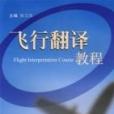《飛行翻譯教程》是2007年西南交通大學出版社出版的圖書,作者是陳艾莎。
基本介紹
- 中文名:飛行翻譯教程
- 作者:陳艾莎
- 出版社:西南交大
- 出版時間:2007年3月1日
- 定價:35.8 元
- ISBN:9787811045635
內容提要,目錄,
內容提要
飛行課程的目的是幫助那些有興趣成為飛行航空英語口譯。是他們應該做的所有飛行譯員的翻譯和解釋飛行人員的初始培訓,經常性的培訓,和會話培訓。這是一個特定的任務的飛行口譯。為了完成任務飛行口譯員被要求的英語語言能力以及具體的能力飛行航空英語
Flight Interpretation Course is designed to help those who are interested in aviation English to become flight interpreters.To be flight interpreters they should do all the translations and interpretations for flight crews in the initial trainings, the recurrent trainings, and the conversational trainings. This is a specific task for the flight interpreters. In order to accomplish the task the flight interpreters are required the English language proficiency as well as specific competence of Flight Aviation English.
Flight Interpretation Course covers all the information required for the flight training:the principle of flight; aircraft systems ; flight procedures ; performance; the basic techniques of flight; the aviation weather; JEPPESON charts; radiotelephony communication. All information is discussed in the book without aeronautical details but with general knowledge that might be appropriate to a comprehension level. The book has tried to avoid technical language and aeronautical jargon as much as possible in favor of plain language. And because diagrams are frequently more helpful than reading the text, the book is amply illustrated with photographs.
Flight Interpretation Course focuses upon the Chinese translation and interpretation of flight aviation English. For flight interpreters oral interpretation is of most importance, so is the listening comprehension, therefore Flight Interpretation Course has prepared large quantity of various kinds of exercises for oral interpreting practice and listening exercises.The course also presents many figures and videos for better comprehension.
目錄
UNIT ONE AIRCRAFT SYSTEMS
LESSON ONE Air Conditioning System
LESSON TWO Pressurization
LESSON THREE Autopilot (Ⅰ)
LESSON FOUR Autopilot (Ⅱ)
LESSON FIVE Communication
LESSON SIX Flight Control System (Ⅰ)
LESSON SEVEN Flight Control System (Ⅱ)
LESSON EIGHT Fire Protection (Ⅰ)
LESSON NINE Fire Protection (Ⅱ)
LESSON TEN Electrical System (Ⅰ)
LESSON ELEVEN Electrical System (Ⅱ)
LESSON TWELVE Fuel
LESSON THIRTEEN Hydraulic System
LESSON FOURTEEN Ice and Rain Protection System
LESSON FIFTEEN EIS
LESSON SIXTEEN EFIS
LESSON SEVENTEEN ECAM
LESSON EIGHTEEN Landing Gear
LESSON NINETEEN Power Plant
LESSON TWENTY Navigation (Ⅰ)
LESSON TWENTY-ONE Navigation (Ⅱ)
LESSON TWENTY-TWO APU
UNIT TWO FLIGHT PROCEDURE
LESSON TWENTY-THREE Preflight Procedure
LESSON TWENTY-FOUR Taxi
LESSON TWENTY-FIVE Takeoff
LESSON TWENTY-SIX Climb
LESSON TWENTY-SEVEN Cruise
LESSON TWENTY- EIGHT Descent
LESSON TWENTY-NINE Approach
LESSON THIRTY Landing
UNIT THREE FLIGHT TECHNIQUES
LESSON THIRTY-ONE Rejected Takeoff
LESSON THREE-TWO Engine Failure on Takeoff
LESSON THIRTY-THREE Windshear
LESSON THIRTY-FOUR Engine out
LESSON THIRTY-FIVE Steep Turn and Stalling
LESSON THIRTY-SIX Turbulence
LESSON THIRTY-SEVEN Emergency Descent
LESSON THIRTY-EIGHT Non-precision Approach
LESSON THIRTY-NINE Wake Turbulence
UNIT FOUR PRACTICAL SCIENCE OF FLIGHT
LESSON FORTY Principle of Flight
UNIT FIVE AVIATION WEATHER
LESSON FORTY-ONE Weather Hazards
UNIT SIX THE FLYING ENVIRONMENT
LESSON FORTY-TWO Airport and Airspace
UNIT SEVEN JEPPESEN CHARTS
LESSON FORTY-THREE Approach Charts
APPENDIX
CAAC FLIGHT ENGLISH INTERPRETER CERTIFICATE TEST
GENERAL INTRODUCTION OF CAAC FLIGHT INTERPRETER CERTIFICATE TEST
References

